News & Announcements
- Details
- Written by Graham Waite
Graham Waite, superintendent, Northern Territory Police, Australia, discusses the Territory''s pre-court juvenile diversion scheme, which provides alternatives, such as Real Justice conferencing, to prosecution and sentencing of young offenders (including Aboriginal youth), in the formal justice system. The scheme produced significant decreases in reoffending and high satisfaction levels. The paper was presented at the first in a series of three IIRP conferences with the theme, "Building a Global Alliance for Restorative Practices and Family Empowerment," in Veldhoven, Netherlands, August 28-30, 2003.
- Details
- Written by Roel van Pagée, Joke Henskens-Reijman
Joke Henskens-Reijman and Roel van Pagée, principals, Terra College, The Hague, Netherlands, speak of their encouraging experiences implementing restorative practices in two large, urban secondary schools where the ethnic make up has recently changed from a homogeneous Dutch population to one that includes children from multiple ethnic and national backgrounds. The paper was presented at the first in a series of three IIRP conferences with the theme, "Building a Global Alliance for Restorative Practices and Family Empowerment," in Veldhoven, Netherlands, August 28-30, 2003.
- Details
- Written by Karin Gunderson
Karin Gunderson, of the Northwest Institute for Children and Families, University of Washington School of Social Work, Seattle, Washington, U.S.A, reports the positive results of two significant studies on family group conferencing (FGC): "Long Term and Immediate Outcomes of Family Group Conferencing in Washington State," June 2000, and "''Connected and Cared for'': Family Group Conferencing for Youth in Care," June 2002. The paper was presented at the first in a series of three IIRP conferences with the theme, "Building a Global Alliance for Restorative Practices and Family Empowerment," in Veldhoven, Netherlands, August 28-30, 2003.
- Details
- Written by Lode Walgrave
Lode Walgrave, of Katholieke Universiteit Leuven, Belgium, speaks about the Belgian juvenile justice initiative, which has addressed serious juvenile offenses, including arson, carjacking, armed robbery, serious physical violence and aggravated theft, using the New Zealand model of family group conferencing (FGC), with cases referred by youth court judges. The paper was presented at the first in a series of three IIRP conferences with the theme, "Building a Global Alliance for Restorative Practices and Family Empowerment," in Veldhoven, Netherlands, August 28-30, 2003.
- Details
- Written by Paul McCold, Ted Wachtel
This paper by Paul McCold and Ted Wachtel presents a concise summary of the restorative justice theory that the IIRP has promulgated over the last several years. The theory provides the framework for a comprehensive answer to the how, what and who of the restorative justice paradigm. The paper was presented by Paul McCold at the XIII World Congress of Criminology, August 10-15, 2003, Rio de Janeiro, Brazil. Also available in Portuguese and Spanish languages.
- Details
- Written by Paul McCold
Paper presented at the XIII World Congress of Criminology,
10-15 August 2003, Rio de Janeiro.
Restorative justice is a new way of looking at criminal justice that focuses on repairing the harm done to people and relationships rather than on punishing offenders. Originating in the 1970s as mediation between victims and offenders, in the 1990s restorative justice broadened to include communities of care as well, with victims’ and offenders’ families and friends participating in collaborative processes called “conferences” and “circles.” This new focus on healing and the related empowerment of those affected by a crime seems to have great potential for enhancing social cohesion in our increasingly disconnected societies. Restorative justice and its emerging practices constitute a promising new area of study for social science.
In this paper, we propose a conceptual theory of restorative justice so that social scientists may test these theoretical concepts and their validity in explaining and predicting the effects of restorative justice practices. The foundational postulate of restorative justice is that crime harms people and relationships and that justice requires the healing of the harm as much as possible. Out of this basic premise arise key questions: who is harmed, what are their needs and how can those needs be met?
A CONCEPTUAL THEORY OF RESTORATIVE JUSTICE
Restorative justice is a collaborative process involving those most directly affected by a crime, called the “primary stakeholders,” in determining how best to repair the harm caused by the offense. But who are the primary stakeholders in restorative justice and how shall they be involved in the search for justice? Our proposed theory of restorative justice has three distinct but related conceptual structures: the Social Discipline Window (Wachtel, 1997, 2000; Wachtel & McCold, 2000), Stakeholder Roles (McCold, 1996, 2000) and the Restorative Practices Typology (McCold, 2000; McCold & Wachtel, 2002). Each of these, in turn, explains the how, what and who of restorative justice theory.
Social Discipline Window
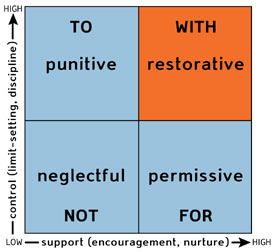 |
|
Figure 1. Social Discipline Window
|
Everyone with an authority role in society faces choices in deciding how to maintain social discipline: parents raising children, teachers in classrooms, employers supervising employees or justice professionals responding to criminal offences. Until recently, Western societies have relied on punishment, usually perceived as the only effective way to discipline those who misbehave or commit crimes.
Punishment and other choices are illustrated by the Social Discipline Window (Figure 1), which is created by combining two continuums: “control,” exercising restraint or directing influence over others, and “support,” nurturing, encouraging or assisting others. For simplicity, the combinations from each of the two continuums are limited to “high” and “low.” Clear limit-setting and diligent enforcement of behavioral standards characterize high social control. Vague or weak behavioral standards and lax or nonexistent regulation of behavior characterize low social control. Active assistance and concern for well-being characterize high social support. Lack of encouragement and minimal provision for physical and emotional needs characterize low social support. By combining a high or low level of control with a high or low level of support the Social Discipline Window defines four approaches to the regulation of behavior: punitive, permissive, neglectful and restorative.
The punitive approach, with high control and low support, is also called “retributive.” It tends to stigmatize people, indelibly marking them with a negative label. The permissive approach, with low control and high support, is also called “rehabilitative” and tends to protect people from experiencing the consequences of their wrongdoing. Low control and low support are simply neglectful, an approach characterized by indifference and passivity.
The restorative approach, with high control and high support, confronts and disapproves of wrongdoing while affirming the intrinsic worth of the offender. The essence of restorative justice is collaborative problem-solving. Restorative practices provide an opportunity for those who have been most affected by an incident to come together to share their feelings, describe how they were affected and develop a plan to repair the harm done or prevent a reoccurrence. The restorative approach is reintegrative, allowing the offender to make amends and shed the offender label.
Four words serve as a shorthand to distinguish the four approaches: NOT, FOR, TO and WITH. If neglectful, one would NOT do anything in response to offending behavior. If permissive, one would do everything FOR the offender, asking little in return and often making excuses for the wrongdoing. If punitive, one would respond by doing things TO the offender, admonishing and punishing, but asking little thoughtful or active involvement of the offender. If restorative, one engages WITH the offender and others, encouraging active and thoughtful involvement from the offender and inviting all others affected by the offense to participate directly in the process of healing and accountability. Cooperative engagement is a critical element of restorative justice.
Stakeholder Roles
 |
|
Figure 2. Stakeholder Roles
|
The second structure of our theory of restorative justice, the Stakeholder Roles (Figure 2), relates the harm caused by the offense to the specific needs of each stakeholder created by that offense, and to the restorative responses required to meet those needs. This causal structure distinguishes the interests of the primary stakeholders—those most affected by a specific offense—from those indirectly affected.
The primary stakeholders are, principally, the victims and offenders, because they are the most directly affected. But those who have a significant emotional connection with a victim or offender, such as parents, spouses, siblings, friends, teachers or co-workers, are also directly affected. They constitute the victims’ and offenders’ communities of care. The harm done, needs created and the restorative responses of primary stakeholders are specific to the particular offense and require active participation to achieve the greatest healing.
The secondary stakeholders include those who live nearby or those who belong to educational, religious, social or business organizations whose area of responsibility or participation includes the place or people affected by the incident. The whole of society, as represented by government officials, is also a secondary stakeholder. The harm to both sets of secondary stakeholders is vicarious and impersonal; their needs are aggregate, not specific, and their most restorative response is to support restorative processes in general.
All primary stakeholders need an opportunity to express their feelings and have a say in how to repair the harm. Victims are harmed by the loss of control they experience as a result of the offense. They need to regain a sense of personal power. This empowerment is what transforms victims into survivors. Offenders damage their relationships with their own communities of care by betraying trust. To regain that trust, they need to be empowered to take responsibility for their wrongdoing. Their communities of care meet their needs by ensuring that something is done about the incident, that its wrongfulness is acknowledged, that constructive steps are taken to prevent further offending and that victims and offenders are reintegrated into their respective communities.
The secondary stakeholders, those who are not emotionally connected to the specific victims and offenders, must not steal the conflict from those to whom it belongs by interfering with the opportunity for healing and reconciliation. The most restorative response for the secondary stakeholders is to support and facilitate processes in which the primary stakeholders determine for themselves the outcome of the case. Such processes will reintegrate both victims and offenders and simultaneously strengthen civil society by enhancing social cohesion and empowering and improving the citizenry’s ability to solve its own problems.
Restorative Practices Typology
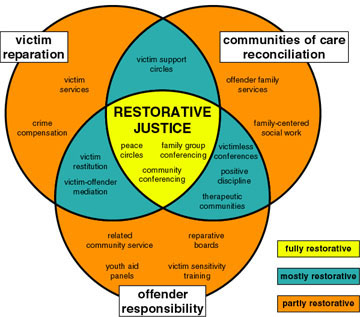 |
|
Figure 3. Restorative Practices Typology
|
Restorative justice is a process involving the primary stakeholders in determining how best to repair the harm done by an offense. The three primary stakeholders in restorative justice are victims, offenders and their communities of care, whose needs are, respectively, getting reparation, taking responsibility and achieving reconciliation. The degree to which all three are involved in meaningful emotional exchange and decision-making is the degree to which any form of social discipline can be termed fully “restorative.” These three sets of primary stakeholders are represented by the three overlapping circles in Figure 3. The very process of interacting is critical to meeting stakeholders’ emotional needs. The emotional exchange necessary for meeting the needs of all those directly affected cannot occur with only one set of stakeholders participating. The most restorative processes involve the active participation of all three sets of primary stakeholders.
When criminal justice practices involve only one group of primary stakeholders, as in the case of governmental financial compensation for victims, the process can only be called “partly restorative.” When a process such as victim-offender mediation includes two principal stakeholders but excludes their communities of care, the process is “mostly restorative.” Only when all three sets of primary stakeholders are actively involved, such as in conferences or circles, is a process “fully restorative.”
CONCLUSION
Crimes harm people and relationships. Justice requires that harm be repaired as much as possible. Restorative justice is not done because it is deserved, but because it is needed. Restorative justice is ideally achieved through a cooperative process involving all the primary stakeholders in determining how best to repair the harm done by the offense.
The conceptual theory presented here provides the framework for a comprehensive answer to the how, what and who of the restorative justice paradigm. The Social Discipline Window describes how conflict can be transformed into cooperation. The Stakeholder Roles structure demonstrates that repair of the emotional and relational harm necessitates the empowerment of the primary stakeholders, those most directly affected. The Restorative Practices Typology demonstrates why participation of the victims, offenders and their communities of care are all required to repair the harm caused by the criminal act.
A criminal justice system that merely doles out punishment to offenders and sidelines victims does not address the emotional or relational needs of those who have been affected by crime. In a world where people feel increasingly alienated, restorative justice restores and builds positive feelings and relationships. A restorative criminal justice system aims not just to reduce crime, but to reduce the impact of crime as well. The capacity of restorative justice to address these emotional and relational needs and engage the citizenry in doing so is the key to achieving and sustaining a healthy civil society.
REFERENCES
McCold, P. (1996). Restorative justice and the role of community. In B. Galaway & J. Hudson (Eds.), Restorative Justice: International Perspectives (pp. 85-102). Monsey, NY: Criminal Justice Press.
McCold, P. (2000). Toward a mid-range theory of restorative criminal justice: A reply to the Maximalist model. Contemporary Justice Review, 3(4), 357-414.
McCold, P., & Wachtel, T. (2002). Restorative justice theory validation. In E. Weitekamp and H-J. Kerner (Eds.), Restorative Justice: Theoretical Foundations (pp. 110-142). Devon, UK: Willan Publishing.
Wachtel, T. (1997). Real Justice: How to Revolutionize our Response to Wrongdoing. Pipersville, PA: Piper’s Press.
Wachtel, T. (2000). Restorative practices with high-risk youth. In G. Burford & J. Hudson (Eds.), Family Group Conferencing: New Directions in Community Centered Child & Family Practice (pp. 86-92). Hawthorne, NY: Aldine de Gruyter.
Wachtel, T., & McCold, P. (2000). Restorative justice in everyday life. In J. Braithwaite and H. Strang (Eds.), Restorative Justice in Civil Society (pp. 117-125). New York: Cambridge University Press.
- Details
- Written by Paul McCold
Ponencia presentada en el XIII Congreso Mundial sobre Criminología,
del 10 al 15 de agosto de 2003, en Rîo de Janeiro.
La justicia restaurativa es una nueva manera de considerar a la justicia penal la cual se concentra en reparar el daño causado a las personas y a las relaciones más que en castigar a los delincuentes. La justicia restaurativa surgió en la década de los años 70 como una forma de mediación entre víctimas y delincuentes y en la década de los años 90 amplió su alcance para incluir también a las comunidades de apoyo, con la participación de familiares y amigos de las víctimas y los delincuentes en procedimientos de colaboración denominados “reuniones de restauración” y “círculos.” Este nuevo enfoque en el proceso de subsanación para las personas afectadas por un delito y la obtención de control personal asociado parece tener un gran potencial para optimizar la cohesión social en nuestras sociedades cada vez más indiferentes. La justicia restaurativa y sus prácticas emergentes constituyen una nueva y promisoria área de estudio para las ciencias sociales.
En la presente ponencia, proponemos una teoría conceptual sobre la justicia restaurativa para que los científicos sociales puedan evaluar estos conceptos teóricos y su validez para explicar y predecir los resultados de las prácticas de justicia restaurativa. El postulado fundamental de la justicia restaurativa es que el delito perjudica a las personas y las relaciones y que la justicia necesita la mayor subsanación del daño posible. De esta premisa básica surgen preguntas clave: ¿quién es el perjudicado, cuáles son sus necesidades y cómo se pueden satisfacer dichas necesidades?
UNA TEORÍA CONCEPTUAL SOBRE JUSTICIA RESTAURATIVA
La justicia restaurativa es un proceso de colaboración que involucra a las “partes interesadas primarias,” es decir, a las personas afectadas de forma más directa por un delito, en la determinación de la mejor manera de reparar el daño causado por el delito. Pero, ¿quiénes son las partes interesadas primarias en la justicia restaurativa y cómo deben participar en la búsqueda de la justicia? La teoría de justicia restaurativa que proponemos cuenta con tres estructuras conceptuales distintas pero relacionadas: la Ventana de la disciplina social (Wachtel 1997, 2000; Wachtel & McCold 2000), la Función de las partes interesadas (McCold 1996, 2000), y la Tipología de las prácticas restaurativas (McCold 2000; McCold & Wachtel, 2002). Cada una de ellas, a su vez, explica el cómo, qué y quién de la teoría de justicia restaurativa.
Ventana de la disciplina social
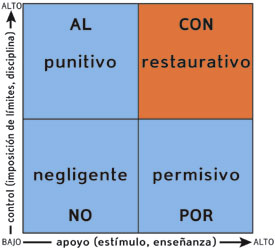 |
|
Figura 1. Ventana de la disciplina social
|
Toda persona en la sociedad con un papel que suponga autoridad enfrenta opciones al decidir cómo mantener la disciplina social: los padres que educan a sus hijos, los maestros en las aulas, los empleadores que supervisan a los empleados o los profesionales de la justicia que actúan ante los delitos. Hasta hace poco las sociedades occidentales se basaban en el castigo, generalmente percibido como la única manera eficaz de disciplinar a aquellas personas que proceden mal o cometen un delito.
El castigo y otras opciones están ilustrados en la Ventana de la disciplina social (Figura 1), la cual se genera mediante la combinación de dos secuencias: “control,” imponer limitaciones o ejercer influencia sobre otros, y “apoyo,” enseñar, estimular o asistir a otros. Por razones de simplicidad, las combinaciones de cada una de las dos secuencias se limitan a “alto” y “bajo.” Un control social alto se caracteriza por la imposición de límites bien definidos y el pronto cumplimiento de los principios conductuales. Un control social bajo se caracteriza por principios conductuales imprecisos o débiles y normas de conducta poco estrictas o inexistentes. Un apoyo social alto se caracteriza por la asistencia activa y el interés por el bienestar. Un apoyo social bajo se caracteriza por la falta de estímulo y la mínima consideración por las necesidades físicas y emocionales. Mediante la combinación de un nivel alto o bajo de control con un nivel alto o bajo de apoyo la Ventana de la disciplina social define cuatro enfoques para la reglamentación de la conducta: punitivo, permisivo, negligente y restaurativo.
El enfoque punitivo, con control alto y apoyo bajo, se denomina también “retributivo.” Tiende a estigmatizar a las personas, marcándolas indeleblemente con una etiqueta negativa. El enfoque permisivo, con control bajo y apoyo alto, se denomina también “rehabilitativo” y tiende a proteger a las personas para que no sufran las consecuencias de sus delitos. Un control bajo y un apoyo bajo son simplemente negligentes, un enfoque caracterizado por la indeferencia y la pasividad.
El enfoque restaurativo, con control alto y apoyo alto, confronta y desaprueba los delitos al tiempo que ratifica el valor intrínseco de los delincuentes. La esencia de la justicia restaurativa es la resolución de problemas de manera colaboradora. Las prácticas restaurativas brindan una oportunidad para que aquellas personas que se hayan visto más afectadas por un incidente se reúnan para compartir sus sentimientos, describir cómo se han visto afectadas y desarrollar un plan para reparar el daño causado o evitar que ocurra nuevamente. El enfoque restaurativo es reintegrativo y permite que el delincuente se rectifique y se quite la etiqueta de delincuente.
Cuatro palabras sirven como referencia para distinguir los cuatro enfoques: NO, POR, AL y CON. Si el enfoque es negligente, NO se hará nada en respuesta a la conducta delictiva. Si es permisivo, se hará todo POR el delincuente, pidiendo poco a cambio y a menudo tratando de justificar el delito. Si es punitivo, se responderá haciéndole algo AL delincuente, amonestándolo y castigándolo, pero esperando poca participación reflexiva o activa por parte del delincuente. Si es restaurativo, se comprometerá CON el delincuente y otras personas, fomentando una participación activa y reflexiva por parte del delincuente e invitando a todas aquellas personas afectadas por el delito a participar directamente en el proceso de subsanación y de aceptación de responsabilidad. El compromiso cooperativo es un elemento fundamental de la justicia restaurativa.
Función de las partes interesadas.
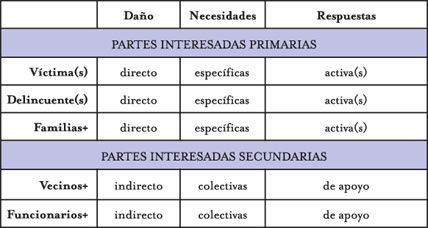 |
|
Figura 2. Función de las partes interesadas
|
La segunda estructura de nuestra teoría de justicia restaurativa, las Funciones de las partes interesadas (Figura 2), relaciona el daño ocasionado por el delito con las necesidades específicas de cada parte interesada que surgieron a partir de dicho delito y con las respuestas restaurativas necesarias para satisfacer dichas necesidades. Esta estructura causal diferencia los intereses de las partes interesadas primarias -aquellas personas más afectadas por un delito específico- de los de las personas indirectamente afectadas.
Las partes interesadas primarias son, principalmente, las víctimas y los delincuentes puesto que son las partes más afectadas directamente. Pero aquellos que tienen una conexión afectiva importante con la víctima o el delincuente, como por ejemplo, padres, cónyuges, hermanos, amigos, maestros o compañeros de trabajo, también se ven directamente afectados. Ellos constituyen las comunidades de apoyo de las víctimas y los delincuentes. El daño ocasionado, las necesidades creadas y las respuestas restaurativas de las partes interesadas primarias son específicas del delito en particular y exigen una participación activa para lograr el mayor nivel de subsanación.
Las partes interesadas secundarias incluyen a aquellas personas que viven cerca o a aquellas que pertenecen a organizaciones educativas, religiosas, sociales o comerciales cuya área de responsabilidad o participación abarca el lugar o las personas afectadas por el incidente. Toda la sociedad, representada por funcionarios del gobierno, constituye también una parte interesada secundaria. El daño causado a ambos grupos de partes interesadas secundarias es indirecto e impersonal, sus necesidades son colectivas e inespecíficas, y su mayor respuesta restaurativa es apoyar los procedimientos restaurativos en general.
Todas las partes interesadas primarias necesitan una oportunidad para expresar sus sentimientos y participar en la decisión sobre la manera de reparar el daño. Las víctimas se ven perjudicadas por la pérdida de control que sufren como consecuencia del delito. Necesitan recuperar un sentido de dominio personal. Esta obtención de control personal es lo que transforma a las víctimas en sobrevivientes. Los delincuentes dañan sus relaciones con sus propias comunidades de apoyo traicionando la confianza. Para recobrar esa confianza, necesitan obtener control personal para asumir la responsabilidad por el delito cometido. Sus comunidades de apoyo satisfacen sus necesidades asegurando que se haga algo con respecto al incidente, que se reconozca su carácter erróneo, que se tomen medidas constructivas para evitar que ocurran otros delitos y que las víctimas y los delincuentes se reintegren en sus respectivas comunidades.
Las partes interesadas secundarias, aquellas personas que no se encuentran emocionalmente vinculadas a las víctimas o los delincuentes específicos, no deben despojar del conflicto a aquellos a quienes les pertenece interfiriendo en la oportunidad de subsanación y reconciliación. La respuesta más restaurativa para las partes interesadas secundarias es apoyar y facilitar los procedimientos en los que las partes interesadas primarias deciden por ellas mismas el resultado del caso. Dichos procedimientos reinsertarán a las víctimas y los delincuentes y al mismo tiempo fortalecerán a la sociedad civil mediante la optimización de la cohesión social y la obtención de control personal y mejoramiento de la capacidad de los ciudadanos para resolver sus propios problemas.
Tipología de las prácticas restaurativas
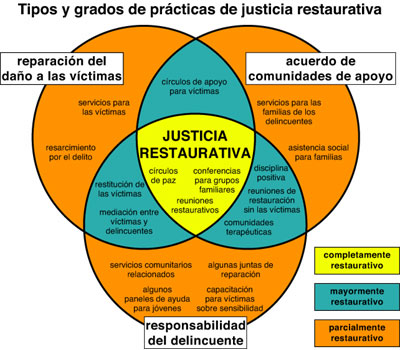 |
|
Figura 3. Tipología de las prácticas restaurativas
|
La justicia restaurativa es un proceso que involucra a las partes interesadas primarias en la decisión sobre la mejor manera de reparar el daño ocasionado por un delito. Las tres partes interesadas primarias en la justicia restaurativa son las víctimas, los delincuentes y sus comunidades de apoyo, cuyas necesidades son, respectivamente, lograr la reparación del daño, asumir la responsabilidad y llegar a un acuerdo. El grado en que las tres partes participan en intercambios emocionales significativos y la toma de decisiones es el grado según el cual toda forma de disciplina social puede ser calificada como completamente “restaurativa.” Estos tres grupos de partes interesadas primarias están representados por tres círculos superpuestos en la Figura 3. El propio proceso de interacción es fundamental para satisfacer las necesidades emocionales de las partes interesadas. El intercambio emocional necesario para satisfacer las necesidades de todas aquellas personas directamente afectadas no puede tener lugar con la participación de un solo grupo de partes interesadas. Los procesos más restaurativos incluyen la participación activa de los tres grupos de partes interesadas primarias.
Cuando las prácticas de la justicia penal incluyen sólo a un grupo de partes interesadas primarias, como en el caso del resarcimiento económico para las víctimas por parte del gobierno, el proceso sólo se puede llamar “parcialmente restaurativo.” Cuando un procedimiento como el de mediación entre víctimas y delincuentes incluye dos partes interesadas principales pero excluye a las comunidades de apoyo, el proceso es “mayormente restaurativo.” El proceso es “completamente restaurativo” sólo cuando los tres grupos de partes interesadas primarias participan activamente, como por ejemplo en reuniones de restauración o círculos.
CONCLUSIÓN
Los delitos dañan a las personas y las relaciones. La justicia exige que el daño se repare tanto como sea posible. La justicia restaurativa no se aplica porque es merecida, sino porque es necesaria. La justicia restaurativa se logra de manera ideal mediante un proceso cooperativo que involucra a todas las partes interesadas primarias en la decisión sobre la mejor manera de reparar el daño ocasionado por el delito.
La teoría conceptual aquí presentada proporciona el marco para una respuesta global al cómo, qué y quién del paradigma de justicia restaurativa. La Ventana de la disciplina social describe la manera en que el conflicto se puede transformar en colaboración. La estructura de las Funciones de las partes interesadas demuestra que la reparación del daño emocional y relacional requiere la obtención de control personal de las partes interesadas primarias, aquellas personas afectadas de forma más directa. La Tipología de las prácticas restaurativas demuestra el motivo por el cual la participación de las víctimas, los delincuentes y sus comunidades de apoyo es necesaria para reparar el daño causado por el acto delictivo.
Un sistema de justicia penal que solamente imparte castigos a los delincuentes y excluye a las víctimas no encara las necesidades emocionales y relacionales de aquellas personas que se vieron afectadas por el delito. En un mundo donde las personas se sienten cada vez más alienadas, la justicia restaurativa restablece y desarrolla sentimientos y relaciones positivos. Un sistema restaurativo de justicia penal apunta no sólo a reducir la cantidad de delitos, sino también a disminuir el impacto de los mismos. La capacidad de la justicia restaurativa de tratar estas necesidades emocionales y relacionales y de comprometer a los ciudadanos en el proceso es la clave para lograr y mantener una sociedad civil sana.
REFERENCIAS BIBLIOGRÁFICAS
McCold, P. (1996). Restorative justice and the role of community [La justicia restaurativa y la función de la comunidad]. En B. Galaway & J. Hudson (Eds.) Restorative Justice: International Perspectives (pp. 85-102). Monsey, NY: Criminal Justice Press.
McCold, P. (2000). Toward a mid-range theory of restorative criminal justice: A reply to the Maximalist model [Hacia una teoría de justicia restaurativa penal de alcance intermedio: Una respuesta al modelo Maximalista]. Contemporary Justice Review, 3(4), 357-414.
McCold, P., & Wachtel, T. (2002). Restorative justice theory validation [Validación de la teoría de justicia restaurativa]. En E. Weitekamp and H-J. Kerner (Eds.), Restorative Justice: Theoretical Foundations (pp. 110-142). Devon, UK: Willan Publishing.
Wachtel, T. (1997). Real Justice: How to Revolutionize our Response to Wrongdoing [La justicia verdadera: Cómo cambiar radicalmente nuestra respuesta ante los delitos]. Pipersville, PA: Piper’s Press.
Wachtel. T. (2000). Restorative practices with high-risk youth [Prácticas restaurativas con jóvenes de alto riesgo]. En G. Burford & J. Hudson (Eds.). Family Group Conferencing: New Directions in Community Centered Child & Family Practice (pp. 86-92). Hawthorne, NY: Aldine de Gruyter.
Wachtel, T., & McCold, P. (2000). Restorative justice in everyday life [La justicia restaurativa en la vida diaria]. En J. Braithwaite and H. Strang (Eds.), Restorative Justice in Civil Society (pp. 117-125). New York: Cambridge University Press.
- Details
- Written by Paul McCold
Trabalho apresentado no XIII Congresso Mundial de Criminologia,
10-15 Agosto de 2003, Rio de Janeiro.
A justiça restaurativa é uma nova maneira de abordar a justiça penal, que enfoca a reparação dos danos causados às pessoas e relacionamentos, ao invés de punir os transgressores. Tendo se originado nos anos 70 como uma mediação entre vítimas e transgressores, nos anos 90 a justiça restaurativa foi ampliada para incluir comunidades de assistência, com as famílias e amigos das vítimas e transgressores participando de processos colaborativos denominados “conferências” e “círculos”. Este novo enfoque na resolução de conflitos e o conseqüente fortalecimento daqueles afetados por uma transgressão parecem ter o potencial de aumentar a coesão social nas nossas sociedades, cada vez mais distantes umas das outras. A justiça restaurativa e suas práticas emergentes constituem uma nova e promissora área de estudo das ciências sociais.
Nesse trabalho propomos uma teoria conceptual de justiça restaurativa para que os cientistas sociais possam por à prova estes conceitos teóricos e sua validade na explicação e prognóstico das práticas de justiça restaurativa. O postulado fundamental da justiça restaurativa é que o crime causa danos às pessoas e relacionamentos e que a justiça exige que o dano seja reduzido ao mínimo possível. Dessa premissa resultam as seguintes questões chave: Quem foi prejudicado? Quais as suas necessidades? Como atender a essas necessidades?
UMA TEORIA CONCEPTUAL DE JUSTIÇA RESTAURATIVA
A justiça restaurativa é um processo colaborativo que envolve aqueles afetados mais diretamente por um crime, chamados de “partes interessadas principais”, para determinar qual a melhor forma de reparar o dano causado pela transgressão. Mas quem são as principais partes interessadas na justiça restaurativa e como devem se comprometer na busca pela justiça? Nossa proposta teoria de justiça restaurativa é composta de três estruturas conceituais distintas, porém relacionadas: Social Discipline Window - A Janela de Disciplina Social (Wachtel 1997, 2000; Wachtel & McCold 2000), Stakeholder Roles - O Papel das Partes Interessadas (McCold 1996, 2000) e Restorative Practices Typology - A Tipologia das Práticas Restaurativas (McCold 2000; McCold & Wachtel, 2002). Cada uma dessas explica o como, o por quê e o quem da teoria de justiça restaurativa.
A Janela de Disciplina Social
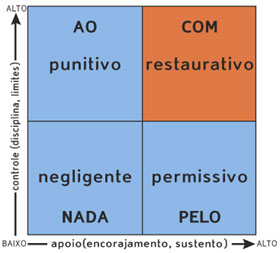 |
|
Figura 1. Janela de Disciplina Social
|
Todos aqueles que têm um cargo de autoridade na sociedade precisam tomar decisões sobre como manter a disciplina social: pais criando filhos, professores em salas de aula, empregadores supervisionando empregados ou profissionais da justiça respondendo a transgressões penais. Até pouco tempo, as sociedades ocidentais vinham utilizando punições, normalmente vistas como a única forma eficiente de disciplinar aqueles que se comportavam mal ou cometiam crimes.
Punição e outras opções estão ilustradas na Janela de Disciplina Social (Figura 1), que é criada pela combinação de dois continuums: “controle”, que limita ou influencia os outros, e “apoio”, cuidando, encorajando ou assistindo outros. Para simplificar, as combinações de cada um desses continuums foram limitadas a “alto” e “baixo”. A delimitação clara de limites e a imposição diligente de padrões de comportamento caracterizam um alto grau de controle social. Padrões vagos ou fracos de comportamento e regulamentos permissivos ou inexistentes caracterizam um baixo controle social. A assistência ativa e preocupação pelo bem-estar coletivo caracterizam o alto apoio social. A falta de encorajamento e uma provisão mínima para necessidades físicas e emocionais caracterizam o baixo apoio social. Combinando um nível alto ou baixo de controle com um nível alto ou baixo de apoio, a Janela de Disciplina Social define quatro abordagens à regulamentação do comportamento: punitiva, permissiva, negligente e restaurativa.
A abordagem punitiva, com alto controle e baixo apoio, também chamada de “retributiva”, tende a estigmatizar as pessoas rotulando-as indelevelmente de forma negativa. A abordagem permissiva, com baixo controle e alto apoio, também chamada “reabilitadora”, tende a proteger as pessoas das conseqüências de suas ações erradas. Baixo controle e baixo apoio são simplesmente negligentes, uma abordagem caracterizada pela indiferença e passividade.
A abordagem restaurativa, com alto controle e alto apoio, confronta e desaprova as transgressões enquanto afirmando o valor intrínseco do transgressor. A essência da justiça restaurativa é a resolução de problemas de forma colaborativa. Práticas restaurativas proporcionam, àqueles que foram prejudicados por um incidente, a oportunidade de reunião para expressar seus sentimentos, descrever como foram afetados e desenvolver um plano para reparar os danos ou evitar que aconteça de novo. A abordagem restaurativa é reintegradora e permite que o transgressor repare danos e não seja mais visto como tal.
Quatro palavras descrevem resumidamente as abordagens: NADA, PELO, AO e COM. Se negligente, NADA faz em resposta a uma transgressão. Se permissiva, tudo faz PELO (por o) transgressor, pedindo pouco em troca e criando desculpas para as transgressões. Se punitiva, as respostas são reações AO transgressor, punindo e reprovando, mas permitindo pouco envolvimento ponderado e ativo do mesmo. Se restaurativa, o transgressor encontra-se envolvido COM o transgressor e outras pessoas prejudicadas, encorajando um envolvimento consciente e ativo do transgressor, convidando outros lesados pela transgressão a participarem diretamente do processo de reparação e prestação de contas. O engajamento cooperativo é elemento essencial da justiça restaurativa.
O Papel das Partes Interessadas
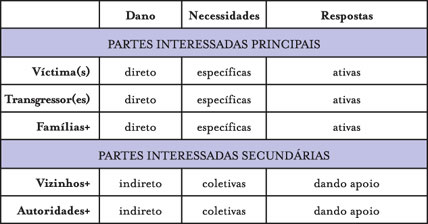 |
|
Figura 2. Papéis das Partes Interessadas
|
A segunda estrutura de nossa teoria de justiça restaurativa, o papel das partes interessadas (Figura 2), relaciona o dano causado pela transgressão às necessidades específicas de cada parte interessada resultantes da mesma, e às respostas restaurativas necessárias ao atendimento destas necessidades. Essa estrutura causal distingue os interesses das partes interessadas principais—aqueles mais afetados pela transgressão—dos afetados indiretamente.
As partes interessadas principais são principalmente constituídas pelas vítimas e os transgressores porque são os mais diretamente afetados. No entanto, aqueles que têm uma relação emocional significativa com uma vítima ou transgressor, como os pais, esposos, irmãos, amigos, professores ou colegas, também são considerados diretamente afetados. Eles constituem as comunidades de assistência a vítimas e transgressores. O dano causado, as necessidades criadas e as atitudes restaurativas das partes interessadas principais são próprias de cada transgressão e precisam de participação ativa da comunidade para alcançar reparação máxima.
As partes interessadas secundárias (indiretas) incluem os vizinhos, aqueles que pertencem a organizações religiosas, educacionais, sociais ou empresas cujas áreas de responsabilidade incluem os lugares ou as pessoas afetadas pela transgressão. A sociedade como um todo, representada pelo governo, também é uma parte interessada secundária. O dano causado às duas partes interessadas secundárias é indireto e impessoal, suas necessidades são coletivas, não específicas, e sua resposta máxima é apoiar os processos restaurativos como um todo.
Todas partes interessadas principais precisam de uma oportunidade para expressar seus sentimentos e ter uma voz ativa no processo de reparação do dano. As vítimas são prejudicadas pela falta de controle que sentem em conseqüência da transgressão. Elas precisam readquirir seu sentimento de poder pessoal. Esse fortalecimento é o que transforma as vítimas em sobreviventes. Os transgressores prejudicam seu relacionamento com suas comunidades de assistência ao trair a confiança das mesmas. Para recriar essa confiança eles devem ser fortalecidos para poderem assumir responsabilidade por suas más ações. Suas comunidades de assistência preenchem suas necessidades garantindo que algo será feito sobre o incidente, que tomarão conhecimento do ato errado, que serão tomadas medidas para coibir novas transgressões e que vítimas e transgressores serão reintegrados às suas comunidades.
As partes interessadas secundárias, que não estão ligadas emocionalmente às vítimas e transgressores, não devem tomar para si o conflito daqueles a quem pertence, interferindo na oportunidade de reconciliação e reparação. A resposta restaurativa máxima para as partes interessadas secundárias deve ser a de apoiar e facilitar os processos em que as próprias partes interessadas principais determinam o que deve ser feito. Estes processos reintegrarão vítimas e transgressores, fortalecendo a comunidade, aumentando a coesão e fortalecendo e ampliando a capacidade dos cidadãos de solucionar seus próprios problemas.
Tipologia das Práticas Restaurativas
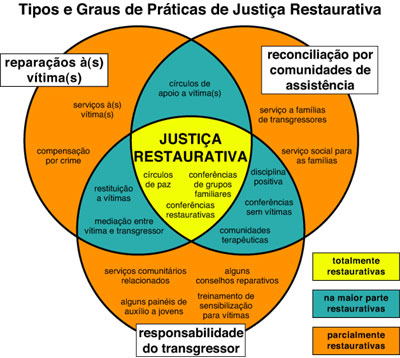 |
|
Figura 3. Tipologia das Práticas Restaurativas
|
A justiça restaurativa é um processo que envolve as partes interessadas principais na decisão de como reparar o dano causado por uma transgressão. As três partes interessadas principais na justiça restaurativa são as vítimas, os transgressores e suas comunidades de assistência, cujas necessidades são, respectivamente: obter a reparação, assumir a responsabilidade e conseguir a reconciliação. O grau de envolvimento das três numa troca emocional e decisões significativas determinará o grau em que qualquer forma de disciplina social poderá ser chamada apropriadamente de “restaurativa”. Esses três grupos de partes interessadas principais são representados pelos três círculos da Figura 3. O próprio processo de interação é crítico para preencher as necessidades emocionais das partes interessadas. O compartilhamento de emoções necessário para atingir os objetivos de todos os que foram diretamente afetados não pode ocorrer através de participação unilateral. O mais restaurativo dos processos requer a participação ativa dos três grupos.
Quando as práticas da justiça penal envolvem apenas um dos grupos de partes interessadas principais, como no caso de compensação financeira do governo às vitimas, o processo só pode ser chamado de “parcialmente restaurativo”. Quando a vítima e o transgressor participam de um processo de mediação sem a participação de suas comunidades, esse será “na maior parte restaurativo”. Apenas quando os três grupos participam ativamente, como em conferências ou círculos, pode ser dito que o processo é “totalmente restaurativo”.
CONCLUSÃO
Crimes causam danos a pessoas e relacionamentos. A justiça requer que o dano seja reparado ao máximo. A justiça restaurativa não é feita porque é merecida e sim porque é necessária. A justiça restaurativa é conseguida idealmente através de um processo cooperativo que envolve todas as partes interessadas principais na determinação da melhor solução para reparar o dano causado pela transgressão.
A teoria conceptual apresentada possibilita uma resposta abrangente que explica o como, o por quê e o quem do paradigma da justiça restaurativa. A Janela de Disciplina Social explica como o conflito pode se transformar em cooperação. A Estrutura de Papéis das Partes Interessadas Principais mostra que para reparar os danos aos sentimentos e relações requer o fortalecimento das partes interessadas principais, afetadas de forma mais direta. A Tipologia das Praticas Restaurativas explica porque a participação da vítima, do transgressor e das comunidades é necessária à reparação do dano causado pelo ato criminoso.
Um sistema de justiça penal que simplesmente pune os transgressores e desconsidera as vítimas não leva em consideração as necessidades emocionais e sociais daqueles afetados por um crime. Em um mundo onde as pessoas sentem-se cada vez mais alienadas, a justiça restaurativa procura restaurar sentimentos e relacionamentos positivos. O sistema de justiça restaurativa tem como objetivo não apenas reduzir a criminalidade, mas também o impacto dos crimes sobre os cidadãos. A capacidade da justiça restaurativa de preencher essas necessidades emocionais e de relacionamento é o ponto chave para a obtenção e manutenção de uma sociedade civil saudável.
REFERÊNCIAS BIBLIOGRÁFICAS
McCold, P. (1996). Restorative justice and the role of community. In B. Galaway & J. Hudson (Eds.), Restorative Justice: International Perspectives (pp. 85-102). Monsey, NY: Criminal Justice Press.
McCold, P. (2000). Toward a mid-range theory of restorative criminal justice: A reply to the Maximalist model. Contemporary Justice Review, 3(4), 357-414.
McCold, P., & Wachtel, T. (2002). Restorative justice theory validation. In E. Weitekamp and H-J. Kerner (Eds.), Restorative Justice: Theoretical Foundations (pp. 110-142). Devon, UK: Willan Publishing.
Wachtel, T. (1997). Real Justice: How to Revolutionize our Response to Wrongdoing. Pipersville, PA: Piper’s Press.
Wachtel. T. (2000). Restorative practices with high-risk youth. In G. Burford & J. Hudson (Eds.). Family Group Conferencing: New Directions in Community Centered Child & Family Practice (pp. 86-92). Hawthorne, NY: Aldine de Gruyter.
Wachtel, T., & McCold, P. (2000). Restorative justice in everyday life. In J. Braithwaite and H. Strang (Eds.), Restorative Justice in Civil Society (pp. 117-125). New York: Cambridge University Press.
- Details
- Written by United Kingdom Home Office
The United Kingdom Home Office published this document (PDF) outlining a strategy for implementing restorative justice in the criminal justice system. The strategy has two elements: (1) to build in high-quality restorative justice at all stages of the UK criminal justice system and (2) to develop understanding of where restorative justice works best and how it could be fully integrated with the justice system in the longer term.
- Details
- Written by Tim Newell
From a speech by Tim Newell
Tim Newell worked for the Prison Service in England for 37 years. He recently retired after ten years as the governor of Grendon and Spring Hill prisons. As governor, he avoided the often punitive and stigmatizing practices of typical prisons. Instead, he created a therapeutic community environment that incorporated principles of restorative practices. The following is from his plenary speech at the IIRP’s Third International Conference in August 2002. In this speech he discussed his experience building these model prison communities, prison culture and how restorative practitioners can overcome institutional resistance.
 |
 |
My first experience with restorative work was actually as a victim. I was living onsite of a young offender establishment. I had been in the job a couple of years and my bachelor home was burglarized by one of the offenders. We were able to quickly establish who it was. In discussing with Barry why he had done it, he said that he was quite interested in getting into a home setting and was interested particularly in my home. Being a bachelor and being at the start of a job, my home was rather sparse. He was unfortunately not well rewarded by the experience. Most young offender establishments have a culture that puts quite an emphasis on personal cleanliness and tidiness. One of the interesting things in the dialogue with Barry was some fairly strong advice he gave me on how to tidy my place up.
I celebrate the work that is taking place at present within prisons. They are demanding places to work in and are very challenging environments in which to introduce some of the ideas we’ve been hearing about at this conference. Over the years, one of the questions I would regularly be asked was, “Why aren’t there more Grendons?” It really is a unique environment where the culture is very different from other prisons. The predominance of fear that dominates most prison settings was by-and-large removed over a period of time through the involvement of and the trust that developed between some very heavy offenders. Half of the 250 prisoners are life sentence prisoners, murderers, rapists and serious offenders. How is it that this culture is not spread to other prisons?
Sadly, prisons are often lacking in hope for the future. If I were a prisoner, I would not be too optimistic about my chances, given the reconviction rates we are dealing with. For young offenders in England, we’re looking at a return to court at 85 to 90 percent within two years of being released. For adults, we are looking at 55 to 60 percent returning to court and a conviction within two years of release. It’s currently something like £35,000 in England to keep someone in for a year. It’s extremely expensive. We now have over 72,000 people, which goes up every week and every month.
Given that the values of restorative work are in conflict with the experience of imprisonment, why do we work in prisons? Why am I asking that we try to focus our work much more in that area? I’m hoping to make a plea to you all to think about your own practice and how that can be applied within a prison setting. I suppose it is because this is where the need is and where the need is the greatest.
The picture that is often presented to me is that it is hard working in prisons. There are the restorative champions who have a lot of information and a lot of skills that they are bringing with them. They work hard to try to move people and ideas. There are often many observers just watching to see what will happen and quite often it feels as though there are a lot of people who are obstructing. This resistance is not personal. It is a dynamic. It’s a dynamic that comes from within the organization. We’ll look at ways in which, perhaps, it is possible to get through some of this obstruction.
I will try to answer a question that was put to me recently. I was at a conference looking at the work of the Thames Valley Police. The assistant chief constable was sitting next to me and handed me a card which read, “Why is it so hard to move the mainstream of the criminal justice system from doing things we know don’t work to doing things we know do?” I expect that’s a question many of us have been asked over the years. He asked me to email him an answer. I’m still working on it. I started doing something about it.
Let’s look at prison culture and values. Obviously, the security role is predominant within most prison cultures. Also, there is a strong subculture of prisoner secrecy and distance from staff. In order to survive, there is secrecy and subculture development. The prison culture is dominated by risk avoidance because sometimes the risks are considered to be far too high. The political pressure is on to try to avoid taking too many risks and avoid making too many mistakes. There is a very hierarchical structure within the prison setting.
In contrast, Grendon had a very clear prime objective. Therapy was its purpose. Men came there to seek to understand themselves and resolve aspects of their past behavior in exploring their current behavior. The treatment ethic was dominant. Everybody was involved in it, including prison officers, people who worked in the administrative departments and myself as governor. I was accountable. I’ve had several interesting sessions in which I was called down to community meetings to explain decisions that I’ve made and give an account as to why things happened in a certain way. The considerable social distance between staff and prisoners was very greatly reduced in order to actually carry out this work.
People were seen very much as equals within the setting. All staff and all prisoners were regarded as therapists. In a therapeutic community, that’s the role everybody takes on. You don’t have experts. You don’t have individual work. You work very much as a community. Whenever there was an issue or a problem, the mantra was, “Take it to your group.” You don’t resolve it in private. You resolve it in public. The ethos of the management was to actually manage risk because the treatment was dependent upon allowing people to make mistakes and establish wider boundaries for their own behavior.
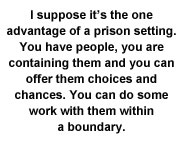 The staff structure was extremely flat. We tried to ensure that as many decisions as possible were made within the communities where the staff was working directly with prisoners. So there were very few decision-making committees within the establishment. One of the key things was that the process was important. Everything that was done was done within an inclusive process so everybody was involved. There was an openness about decisions even when pretty horrible decisions had to be made, such as people being moved on or programs being shut down for lack of finance.
The staff structure was extremely flat. We tried to ensure that as many decisions as possible were made within the communities where the staff was working directly with prisoners. So there were very few decision-making committees within the establishment. One of the key things was that the process was important. Everything that was done was done within an inclusive process so everybody was involved. There was an openness about decisions even when pretty horrible decisions had to be made, such as people being moved on or programs being shut down for lack of finance.
Within that environment, Grendon was able to work. This is in contrast to other prisons. We were able to maintain the work because it was effective. We certainly had the lowest escape rate in England. We had the lowest assault rate of all prisons. Also, we had the highest involvement of prisoners in programs: 100 percent in Grendon. The staff were committed to the regime and practice, so there were no industrial relations issues at all in that environment. All prisoners looked after each other in terms of suicide prevention, so we were able to survive that as well. There was a long waiting list of prisoners wanting to come to the place. We had twice as many people on our waiting list as places in the prison. The reputation spread amongst prisoners that this was the place where they could actually achieve some understanding of themselves and perhaps some capacity to move on and not cause further damage.
Obviously, victims of those people who are in prison are often those most seriously affected by crime. The offenders have been the most damaging people. From my experience working with some of the most damaging people, they are also the most damaged people. Part of what needs to happen in prison is that personal experience of damage should be explored within that setting. I suppose it’s the one advantage of a prison setting. You have people, you are containing them and you can offer them choices and chances. You can do some work with them within a boundary. That’s one of the real advantages.
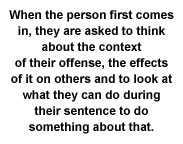 The communities of those people who are in prison are often the most relieved that the person is now behind the wall. But they are often the most anxious about what’s going to happen when this person returns and how that person is likely to behave. The context in which the offense occurred and the effects of the offense are very rarely considered within the prison setting. Before I retired, I was fortunate to have a short period doing some work in three other prisons. We worked with a group of staff within those prisons to look at the functions with which you could use restorative processes. In Winchester, Bristol and Norwich prisons we are working with the whole approach towards sentence management and sentence planning. So when the person first comes in, they are asked to think about the context of their offense, the effects of it on others and to look at what they can do during their sentence to do something about that.
The communities of those people who are in prison are often the most relieved that the person is now behind the wall. But they are often the most anxious about what’s going to happen when this person returns and how that person is likely to behave. The context in which the offense occurred and the effects of the offense are very rarely considered within the prison setting. Before I retired, I was fortunate to have a short period doing some work in three other prisons. We worked with a group of staff within those prisons to look at the functions with which you could use restorative processes. In Winchester, Bristol and Norwich prisons we are working with the whole approach towards sentence management and sentence planning. So when the person first comes in, they are asked to think about the context of their offense, the effects of it on others and to look at what they can do during their sentence to do something about that.
We are working with the anti-bullying policy and the race relations policy. We are working with the adjudications or infractions policy. Instead of going through a formal adjudication process where the warden is the judge and jury and gives the sentence, we suspend all of that and have a circle to determine what should happen as a result of an assault or other anti-social behavior within a prison context. Those are some of the things that are happening within those three prisons now.
There is a major project taking place in England and Wales at present, in the Thames Valley. It is a big research project based in a metropolitan area. It involves about five big prisons, particularly in the Thames Valley, which includes a prison named Bullingdon. There are formal conferences taking place with serious, violent adult offenders. The Home Office has funded it.
There was some concern that the work within Bullingdon prison was taking place without any incentive at all. Prisoners do not get parole or shorter sentences, just offered the opportunity [to participate in a conference]. Out of the 150 or so who fell into this category, about 130 have taken up the offer of doing it. They have now had over 50 conferences in the prison within the last nine months or so, which is really a roller coaster approach, I’m afraid. It’s going very fast. There has been a lot of staff trained to do it, including prison guards facilitating conferences. The effect upon the culture at Bullingdon is something we are looking forward to examining.
In a place called Brinsford, a young offender establishment, there is some very imaginative mediation work taking place between victims in the community and young offenders within the establishment. This includes face-to-face meetings, but more often includes reports, letters or videotapes that are sent in order to try and help both parties understand what happened.
The other aspect is the application of restorative principles to the whole prison. I suppose a place like Grendon would be seen as a totally different cultural approach where the whole prison is accountable and tries to work to a different set of values. We established a core team of prison officers and other staff, a multidisciplinary team. We did some awareness training for all prison staff. We did an audit of all the processes, which produced an action plan that we then prioritized. We have some allies now on the restorative side who are pushing a bit. The obstructers are getting a bit weaker and the observers are jumping off the fence. Since last year, another prison has opened with the same principles. It is called Dovegate. There are other people doing this sort of work, individually motivated, who have to carve out space, protocols and safety to carry out their practice. They have an uphill struggle every time they seek to make this sort of intervention.
The big challenge that is coming up is how do we seek to use this approach with the Headquarters and how do we try to help politicians and mandarins to work in a restorative way. There are some openings coming up. The Home Office is very concerned and is trying to reduce victim dissatisfaction. There are no strategies yet as to how that is going to be done, but one of the key things already coming out of the research from Bullingdon and the Thames Valley is how strongly victims feel committed to the process and how much they have gained from it.
Why is it so hard? The resistance is not a personal thing. I think it’s an organizational thing, it’s a dynamic thing and it’s a cultural thing. Because of the very unusual nature of the work, prisons have evolved a culture, a paradigm and a mindset that determines the way they do the things they have to do. This is a brief look at a model that is more fully described in my paper “Restorative Practice in Prisons: Circles and Conferencing in the Custodial Setting.” (To read this paper go to: www.iirp.edu/article_detail.php?article_id=NDQ1.)
What I would suggest is that we look at using the model to think about the six factors that focus on the paradigm in any organization you’re working in [see below]. I don’t think it just relates to prisons. I think every organization has this cultural web and the structure that supports it. Most consultants go for the easy ones—control systems, power structures and organizational structures—because they are more readily accessible. The important thing for us, I think, is to focus on the subconscious areas: the stories, symbols and rituals. Through that, one can assess the nature of the paradigm and look to develop our own stories, of which we have a massive amount. Our stories, our symbols and our rituals can help the organization meet its needs.
Obviously, stories are vitally important in any culture. What we say to each other and others about how we celebrate or denigrate what happens can determine how we feel about the place. The symbols we have, such as name badges, are important. The simple things that we use within prison settings. The symbolic use of names is vitally important. The director general saw that in private prisons in England, staff refers to prisoners as Mr., Miss or Mrs. So-and-so. Whereas in the public sector prisons, they are always referred to purely by their second or surname. He asked us all to think about how we could change that. The resistance to that has been tremendous and so deeply emotional that it obviously represents a serious symbol that will be difficult to shift.
Rituals and routines are vitally important as well within the subconscious of the culture. What rites of passage are there within the organization: rites of celebration, rites of degradation, rites of challenge and rites of counterchallenge? Paradigms are in the middle of this, which is what is being protected.
 I hope I’ve provided some ideas on how we can get through this resistance and how we can work to change the current state of prisons and our dependency upon them. What I would like to close with is to ask that you consider within your own practice the possibility of moving some of that into a prison setting: either to help people towards their release or to involve yourself during their time in the prison. I see this as the most serious arena for our work. It’s life and death matters that we are considering within prisons.
I hope I’ve provided some ideas on how we can get through this resistance and how we can work to change the current state of prisons and our dependency upon them. What I would like to close with is to ask that you consider within your own practice the possibility of moving some of that into a prison setting: either to help people towards their release or to involve yourself during their time in the prison. I see this as the most serious arena for our work. It’s life and death matters that we are considering within prisons.
I would like to end with some silence. But before the silence I would like to quote something that epitomizes how serious the need for restorative practice is in our society. This is from an English novelist, Ian McEwan, who wrote in The Guardian on the 13th of September last year [2001].
“If the hijackers had been able to imagine themselves into the thoughts and feelings of the passengers, they would have been unable to proceed. It is hard to be cruel once you permit yourself to enter the mind of your victim. Imagining what it is like to be someone other than yourself is at the core of our humanity. It is the essence of compassion and it is the beginning of morality.”
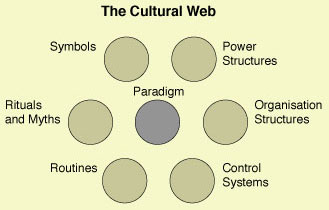 Excerpted from “Restorative Practice in Prisons: Circles and Conferencing in the Custodial Setting” by Tim Newell. In considering the application of restorative ideas in prisons, we could use the model of the cultural web. Through this we could audit the way in which changes are already taking place in some prisons and how more could be achieved through this methodical approach towards cultural change. Restorative practitioners are beginning to work more in prisons and this effort could be considered through the model of the cultural web so that the work is effective within the context of the project but also in affecting the wider prison community. The way that some of this work has been approached has influenced the functional areas of work described below. This work has been achieved by prison staff being dissatisfied with traditional ways of operating and realising that through restorative practice a more satisfactory process could be developed with more just outcomes. Through audit and developing practice it is possible to see there are opportunities in the following areas of functional activity in prisons: Induction programmes for prisoners. Establishing norms through staff and peer tuition and example, through setting standards and developing expectations of taking responsibility during the sentence can be very effective at the start of the sentence when prisoners are often at their most sensitive and receptive. Complaints and requests systems. The requests and complaints of prisoners can be considered through an open process of mediation and direct communication in order to establish what happened, who was affected, in what way and what should be done to put things right. This can be in contrast to some current practice that is often secretive in process and unsatisfactory in outcome for all parties. Adjudications. Disciplinary hearings form a critical focus of many prison systems. How infractions of the rules are considered by the prison sets the tone of staff attitudes and prisoner compliance in many prisons. To offer an alternative process of a circle is a dramatic way to express the concept of staff and prisoners working together to resolve conflicts rather than reacting to them stereotypically. This process can be seen to gain a win-win setting, rather than the inevitable win-lose one of blame and scapegoating. (Continued on next page.) Race relations. Similar handling of equal opportunity issues through open ways of mutual respect can establish for staff and prisoners that such matters are taken seriously. Their concerns will be handled fairly and openly whenever possible, recognising the perceived victim’s feelings and willingness for such a process. Anti-violence strategy. The same considerations apply as for the anti-bullying strategy. The strategy to be developed could well include training for staff and prisoners in conflict-resolution awareness and skills, perhaps through a programme like the AVP (Alternatives to Violence Project). The establishing of peer mediators, as with the ‘listeners’ programme for suicide prevention and the peer education-tutoring scheme, will play to the strengths of many prisoners in managing difficult settings and in being able to support each other. Preparation for release. When sentence planning is done in partnership with prisoners many restorative justice possibilities arise for accepting responsibility for the crime, establishing some accountability for the future to victims, primary and secondary, and a commitment to the community to which prisoners will return. The resources of the prison—work, education, leisure, offending behaviour courses and other programmes—can be channeled to this effect. Victim empathy and accountability for criminal behaviour are expressed in these programmes in which prisoners take responsibility for their behaviour. This is the ideal setting for voluntary compliance, honesty and contrition to be expressed. Resettlement. Preparation for resettlement should start early in the sentence and should engage the agencies that are likely to be affected by the prisoner’s release, such as housing, health and employment, as well as the criminal justice agencies of police and probation. On home leave or temporary release from prison, offer the possibility of a conferencing of agencies, including justice ones, with the prison providing some feedback about the course of the sentence and about future expectations. Family and victims could be involved in this process that is focused on the issues of returning to the community. Circles on release. Once released, the prisoner often experiences difficulties in sustaining the plans and the intentions when in custody. There is sometimes a need to provide some community support and involvement through a formal Circle of Support and Accountability. Prison Outreach. Staff and prisoners can serve the community by educating groups about the effect of imprisonment through the sharing of information about prisons and about the life stories of offenders. Staffing processes. In order to integrate restorative justice practices, principles and processes into the prison’s life it is important that prison staff feel that they are treated with the same respect and consideration. Thus, dispute and conflict resolution procedures should be developed offering mediation and conferencing for staff with trained facilitators. The personnel management of staff should operate with the same principles of concern for the individual and the respect for their personal development within the professional setting. |

Restorative Works Year in Review 2023 (PDF)
All our donors are acknowledged annually in Restorative Works.
